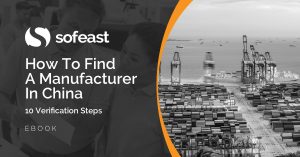As an importer, you are probably wondering how the COVID-19 epidemic in China is going to impact your business.
Beijing says things are rapidly improving and hints that the situation will nearly be back to normal on the coasts by the end of February. They are still planning to hold the Canton fair.
Let’s all hope they are right. Let’s hope there is no relapse (the epidemic starting again in certain cities) in the coming months. The situation is still far from clear.
In the meantime, what risks should importers look out for? Here are the 7 major ones as I see them…
1. Experiencing multiple quality issues
All experienced importers know that Chinese New Year (CNY) is a particularly dangerous period:
- Before CNY, many suppliers have immense pressure to complete productions and ship products out, and the ‘quality gate’ is often bypassed entirely;
- After CNY, a high proportion of workers might be new (not only in production, but also in the quality department), and quality can be quite inconsistent for a couple of months.
How about CNY 2020? Add to this the COVID-19 epidemic, and it multiplies the frequency of occurrence of issues. Here are the factors at play:
- Your Chinese suppliers are short on people, and they have very high pressure to catch up on production delays (like a usual pre-CNY time);
- Many people haven’t come back to work. They probably had to recruit some workers to get some production done, with no time for training (like a usual post-CNY time);
- Some highly-paid key engineers & managers are unable to be in factories;
- Component suppliers are probably not able to re-work or re-produce quickly in case quality issues are found;
- Your foreign staff probably don’t want to fly to China at this time to keep an eye on the situation;
- External quality assurance agencies can’t yet go to certain areas for various reasons (e.g. local government went into lockdown), and so might be unable to help yet.
Do you even know what the situation is, these days, at your top suppliers? You probably rely only on their messages and a few photos.
What can be done to reduce quality issues?
Unfortunately, not very much.
- Make sure not to let shipments go without an inspection if possible.
- Two weeks ago, I mentioned the need for a new type of audit (checking if a factory is ready and has adequate inventory, employees…). If you want to be on top of the situation, you need to send someone to see with their own eyes…
2. Long shipment delays
Let’s say you have a manufacturer in Shenzhen. They make product ABC for you. They buy components from 5 other manufacturers in China, who in turn buy some materials & components from another 10 local suppliers. Your supply chain relies on all those 16 suppliers.
What happens when 1 of the suppliers has restarted their facility late, is severely short on staff, and has very little inventory ready to sell? If it can’t be replaced easily and quickly, this issue may cause a long delay in the shipments of the finished product. Even if the assembler has all the people and machines to do the work.
Delays, like quality problems, cascade down the supply chain. And their impact often amplifies.
To make matters worse, as an importer, you might be between a rock and a hard place:
- On the one hand, your customers may not change their usual requirements. A catalogue company might give you penalties if you don’t deliver on time. Amazon will sell other products if you are out of stock. And so on.
- On the other hand, your Chinese suppliers will probably not accept paying penalties to you. They will use the ‘force majeure’ (if there is one) clause in your contract. And, to begin with, you want to keep on their good side and incite them to prioritize your orders these days… so you can’t make them hate you!
What can be done to reduce long shipment delays?
Are there ways to increase your chances of receiving products without much delay? Dan Harris suggests giving a bonus or signing a long-term contract:
There are lots of things you can do to increase your odds, but usually the best thing is to offer to pay more. If you are paying 100 dollars per widget you might want to test whether paying 120 dollars will get you to the front of the line, because it very well might. Our manufacturing lawyers have engaged in this sort of negotiation many times pre-coronavirus when shipments were delayed for other reasons. Convincing your Chinese manufacturer that you will be with it for the long-haul is another way, but that will likely require you sign a long-term contract evidencing that.
3. Inability to ship urgent orders by air, and delays at the ports
Many, many passenger planes were carrying cargo and are now grounded. Air shipment capacity is far lower and you might be unable to book some space in the coming weeks.
Ports also operate below their usual capacity. This might be back to normal very soon, but the situation of different ports varies.
A lot of merchandise is going to be shipped “ASAP” in the coming weeks. We will see if this forms large backlogs that have to be set aside and wait.
What can be done to circumvent blocked shipments?
Now is the time to use your personal relationship with an account manager working for your freight forwarder. Ask questions and plan accordingly.
If you have no such direct connection, try to find one (We have a couple of logistics experts, and many supply chain management companies have someone working on logistics, so there is still hope! Let me know if you are stuck).
4. Some key suppliers who are unable to work
Many Chinese factory managers neglect to cross-train staff. Very often, in small & medium companies, only 1 technician knows how to set up a special press, or only 1 engineer knows how to maintain a high-tech piece of equipment.
What happens when these 1 or 2 key employees get blocked (as 700+ million Chinese people are) and are unable to get to work at the factory? One of the production processes might be down. And this might make the entire business impossible to run.
What can be done to reduce the impact of suppliers not being able to serve you?
Know the situation. Again, a factory visit to check production readiness can help you.
5. Suppliers who never re-open
We haven’t got a full picture of the situation yet, with many factories unable to open before March 1st. I haven’t heard of any confirmed case of a factory that decided to shut down forever, but there are such stories every year after CNY… and I can’t imagine the situation will be better than usual in 2020.
If a supplier has your tooling in their factory, you might have to write it off entirely.
And there is a special case. The small trading company that, in normal times, usually operates ethically but that, when cash flow is tight and circumstances are out of the ordinary, will scam a few customers.
What can be done to avoid the damage caused by suppliers who go out of business?
Don’t wire any money to suppliers as long as you are not 99% sure they have re-opened and are operating. Ask for proof and re-assurances. Don’t make it easy to scam you.
6. Impact on costs
Nothing in the list of potential problems I drew above will push prices down. (One piece of good news is, prices of most raw materials have plummeted recently. I hope you track the international prices of the commodities used to make your product, as it may allow you to negotiate pricing.)
How do manufacturers hire many new operators? By offering a higher salary, or by paying special bonuses, of course. This might accelerate wage inflation this year.
Logistics will also probably be more expensive in the next few months.
What can be done to reduce the impact of COVID-19 on costs?
Try to have a cost model for your main products. You should be able to answer a few questions. Is labor 30% of the cost? Does the total cost drop a lot if its many materials get 25% cheaper?
Some potential suppliers can give you a lot of information. Your current suppliers, too, if you observe and ask a few good questions.
Then, use this information to challenge your supplier(s) when you are asked to pay more.
7. A mandate from key customers to move production to other countries
Last week, I suggested many companies might feel the imperative to diversify their manufacturing sources out of China. We can feel many decision-makers are reconsidering their sourcing strategies.
A Forbes article mentions this risk clearly:
China’s economy was already under pressure from the two-year-old trade war with the U.S., which saw companies in China start to shift production to Southeast Asian nations in pursuit of lower costs and to avoid the U.S.-China tariffs. The coronavirus crisis has highlighted for foreign companies the dangers of keeping all of one’s “eggs in one basket,” Wuttke said.
Some observers see the coronavirus outbreak as the tipping point in the ongoing downturn of China’s manufacturing sector. Liu Kaiming, head of the Institute of Contemporary Observation, which studies working conditions in factories across China, told the South China Morning Post that if the situation doesn’t calm by March, then “China’s supply chains and status as the ‘world’s factory’ could fall off a cliff”.
If you sell to one, or a few, key customer(s), you might be requested to diversify your sources. (If your suppliers are hit, your customers are also hit!)
What can be done to diversify or cope with disruptions in China at this point?
Start building a supply chain in other areas for your main products. Request quotations, explore new areas. Or be ready to carry a higher amount of inventory, “just in case”.
8. Lower demand in your market
We are probably getting to the end of a long cycle of economic expansion. When will it end?
It is similar to the 1990s boom in several ways. Nobody knows when the recession will hit. The Asian crises of 1997 and the Russian crisis of 1998 didn’t make more than a dent in that period’s growth in the USA and Europe, and Covid-19 might also have no real impact.
The dotcom crash did the job in 2000 & 2001, and 9/11 made the situation worse. These days (in 2020), there is a real estate bubble and a stock market bubble in the US. Something is going to happen… but nobody knows when.
What can be done to protect your business from uncertainty?
Build cash reserves. Don’t be very exposed. The priority is to survive, right?
—
I am sorry for ending on such a negative note. After all, this is an article on business risks, so I don’t think readers expected very positive stories!
What effects are you seeing from COVID-19? Are your suppliers at work yet? Have you been struggling with delays, price-rises, etc?
Are you wondering how to find a manufacturer in China who is well-suited to your needs and can also deliver on their promises?
Sofeast has developed 10 verification steps to help you find the right manufacturer. They’re shared in this FREE eBook: “How To Find A Manufacturer In China: 10 Verification Steps.”
It covers:
- Background checks
- Manufacturing capabilities
- Quality system auditing
- Engineering resources
- Pricing, negotiation, & contracts
- …and much, much more
Just hit the button below to get your copy:


